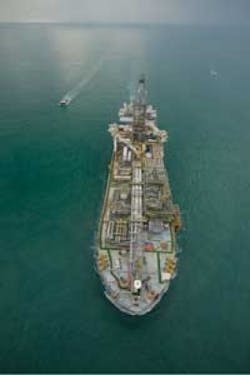Support specialist renovates fleet in readiness for industry's revival
Jeremy Beckman - Editor, Europe
Offshore construction activity is picking up, easing the pressures on support vessel operators. Many have spent heavily on upgrading their fleets, and need to see a return on their investments.
Marseille-based Bourbon Offshore has committed €1.7 billion ($2.17 billion) to a rolling program of newbuilds under its Horizon 2012 project, initiated in 2008. The intake includes 76 of the new-design, Bourbon Liberty series platform supply vessels (PSVs) and anchor-handler tug supply vessels (AHTSs), all commissioned from the Sinopacific shipyards at Dayang and Zheijang in China. The ultimate goal of Horizon 2012 is to double the group’s miscellaneous vessel fleet and to expand its global workforce to around 10,000.
Another aim of the program at the outset was to grow offshore revenue by 21% per year, but market conditions of late have been counter-productive. “Throughout 2009,” says Bourbon Offshore Division Fleet Manager Frank Dambrin, “we had contracts ending which then had to be renewed.
“However, at the end of the year, the situation was very different from when we signed those contracts. The renewal terms have not been as profitable as the old ones, and we have had to struggle more and be more aggressive to secure new contracts. There are a large numbers of vessels joining our fleet, and we have to get contracts for them.
“It has also proved harder to persuade our customers to pay for mobilization of these new vessels from the shipyard in China to their areas of operation. Probably when the market picks up, it will be easier for us and everybody else. We feel there is still some inertia in the system, but things should improve from summer onwards, and that trend should continue next year. One positive sign is an increase in the number of tenders, which means that oil companies are reactivating projects or giving the green light to new ones.”
In some parts of the world, Bourbon has had to contend with more competitors, he points out, “or alternatively their fleets are older, but cheaper to hire than ours.” In other areas, notably Norway, Bourbon has identified excess capacity of newbuild vessels, particularly very large multi-purpose PSVs and anchor-handlers. “But there is no region we are thinking of pulling out of,” Dambrin stresses. “We try to compete wherever there is activity for our vessels, and where we can bring to our customers savings in fuel, time optimization in rig moves, and so on.”
Areas where demand is growing for support services include Brazil, where Bourbon has just acquired full control of its subsidiary company, and deepwater drilling off northwest Africa, where the company won several contracts last year. “In the rest of West Africa, however, the volume of work has been lower, maybe because there are fewer active players at present.”
Liberty arrivals
As in 2009, Bourbon’s investment program continues, and the company expects to take delivery of around 70 new vessels this year. The Liberty series ships delivered to date have already been deployed offshore Asia, the Middle East, the Mediterranean Sea, Brazil, and Mexico. The only major exception is the North Sea.
“The general feedback from our customers is that they are very pleased with these vessels’ performance,” says Dambrin. “They can see the benefits in terms of fuel consumption, and they are also very happy with the maneuverability.”
Both the 100 and 200 series are equipped with diesel-electric propulsion, providing fuel efficiency and cost savings, as generator output can be varied according to the operational load. With both vessels, main systems redundancy is provided by three main generators, two azimuthing stern thrusters, one fixed stern thruster, two bow thrusters, and a DP-2 class dynamic positioning system. And in both cases, the main generators have been transferred to the main deck as opposed to the more conventional location below deck. According to Bourbon, this frees 30% more space for below-deck cargo such as liquid muds. Creating this layout involved a simple rearrangement of the accommodation block onto an additional deck.
The DP-2 system and the azimuthing thrusters allow the vessels to maintain position alongside platforms or rigs for offloading cargo in all types of weather.
“The captain does not have to maintain a specific heading,” Dambrin adds, “so the crews can be kept in the best position to work, away from the worst of the weather.” Clients of the Liberty 100 PSVs have commented favorably on the vessels’ handling capability in DP mode during loading and unloading operations.
As for the Liberty 200 AHTS series, the station-keeping ability improves the safety of crew on deck during anchor-handling. “It allows the vessel to operate on the windward side of the pennant and/or mooring buoy, with the water flow from the propellers pushing the cable away, thereby minimizing the risk of entangling the wire.”
The Liberty 100 PSVs are 57.9 m (190 ft) long, with a breadth of 14 m (46 ft), a maximum draft of 4.9 m (16 ft), a deadweight of 1,509 metric tons (1,663 tons), a service speed of 11.5 knots, and with accommodation for 22 personnel.
The Liberty 200 AHTSs have similar dimensions and accommodation, with a deadweight of 1,460 metric tons (1,609 tons). They are equipped with a MacGregor-Plimsoll dual-drum winch in a waterfall arrangement, with each drum rated at 150 mt (165 t) pull for towing and anchor handling; and a bollard pull capability of 80 mt (85 mt in tests). These vessels also feature a stern roller, shark jaws for secure stopping of chains and wires, and retractable towing pins to center, control, and guide towing lines and cables.
Other developments
Early this year, Bourbon Offshore took delivery ofBourbon Enterprise, the first of two multi-purpose supply vessels on order from the Socarenam shipyard in Boulogne-sur-Mer, northern France. Both are again diesel-electric and DP-2 class, but with accommodation for a larger crew (up to 103 beds). The vessels have been designed by French consultants Marine Assistance and Bureau Mauric to support maintenance of production facilities and subsea inspection campaigns. Both have a low draught to ease access in shallow water zones, and they also are equipped with eight anchors to provide greater positioning flexibility.
Bourbon Enterprise completed sea trials and was due to start its first assignment offshore Tunisia. Delivery of the second vessel, Bourbon Supporter, was delayed due to damage incurred by one of the thrusters while at the yard. However, this vessel too has a letter of intent for a support contract.
Bourbon Offshore continues to augment its fleet of crew boats. As of December 31, 2010, 33 crewboats were under construction, lifting the total fleet to 256.
TheBourbon Front is one vessel in a series of 4 X-bow design vessels, the PX-105. It is currently under construction at the Sinopacific shipyard.
Like other support service specialists, Bourbon Offshore phases out its older vessels where possible. Currently, some tonnage delivered in the late 1990s is on the market. All have contracts, however, and the company is not in a hurry to sell until market conditions improve for vessel trading.
“Our current investment program takes us through 2012,” Dambrin points out. “Should we decide to go for a new long-term program, we still have time. However, if we were to order a new series of boats, it would take two to two and a half years to receive the first one.
“Part of our investment has also been focused on subsea IMR [inspection, maintenance, and repair]. It’s not new for us – we started in this sector two years back – but we are seeing increasing levels of activity.”
In February, Bourbon Subsea Services commissioned Schilling Robotics to develop a new range of ROVS to provide maintenance for existing subsea infrastructure. The HD ROV series will be a compact, work class vehicle capable of transporting loads of up to 250 kg (551 lb), equivalent to the capability of the largest ROVs, the partnership says. It also will be able to handle loads of up to 3,000 kg (6,614 lb) in water depths of up to 3,000 m (9,942 ft). The first two vehicles should be delivered later this year.
Brazil expansion
At the end of 2009, Bourbon Offshore acquired 100% of the share capital of its Brazilian partner Delba Maritima Navegacao, and declared its intention to expand its services to Brazil’s offshore sector. The two companies had operated a joint venture since 2001, which last year operated a fleet of 17 vessels from five locations, with over 500 employees.
“We have a very long-term relationship with Petrobras,” Dambrin explains, “which started via Delba. Petrobras is a very demanding customer, and very smart – they manage their vessel resources in Brazil in a very efficient way, and they always get the levels that they want.”
Last month, the re-named Bourbon Offshore Maritima signed contracts to supply Petrobras with 13 new vessels. These comprise:
- Seven Bourbon Liberty 100 PSVS for four years, starting in June
- One Bourbon Liberty 200, 80-mt (88 t) traction AHTS, for three years from May 2010
- Five 18-m (59-ft) passenger transport crew boats for eight years. They will join other vessels of a similar type that have worked for Petrobras off Brazil for the past two years
Elsewhere, Bourbon Offshore recently established a subsidiary company in Dubai, which will serve as the commercial center for the company’s operations throughout the Middle East, India, and the Mediterranean.
“For the time being we have a team there of about 10 people ashore,” Dambrin says. “They have started managing their first vessel, and will take over another four during 2010.”
Another new subsidiary has been established in Balikpapan, Indonesia, complimenting the company’s growing operation in Singapore, which took on management of 12 vessels last year, with numbers set to exceed 20 by the end of this year.
Singapore is the location for Bourbon Offshore’s second anchor handling tug supply vessel simulator (the first was in Marseille). The facility is used to train crews of AHTSs and PSVs to perform maneuvering operations, using, for instance, azimuthing-type thrusters.
“We have also deployed a series of simulators dedicated to water jet-powered crew boats – our intention is to have a simulator in each country where we operate crew boats. Currently, we have these facilities in Nigeria, Gabon, Cameroon, Angola, and Indonesia.”


